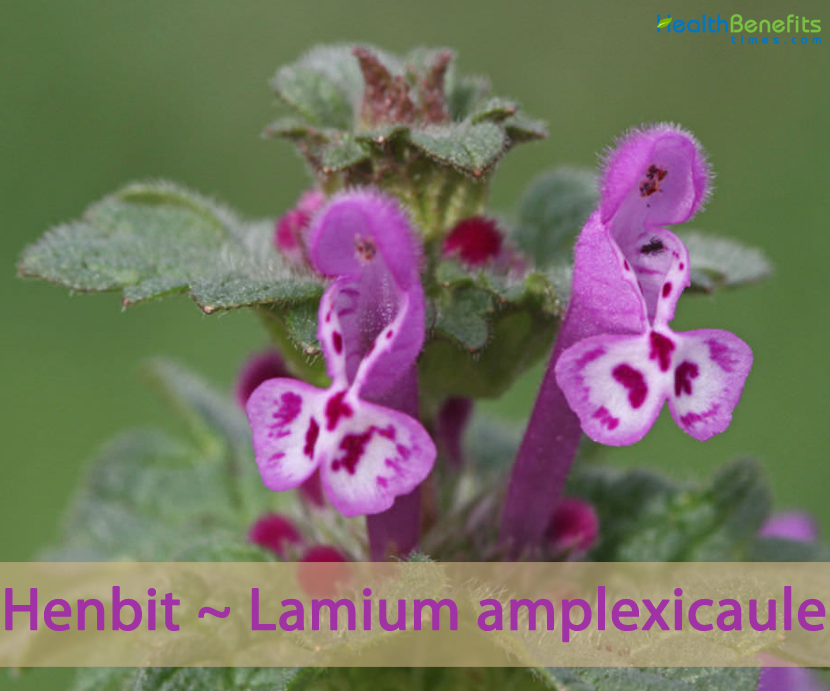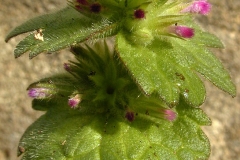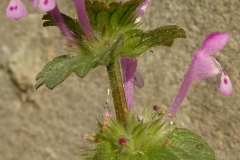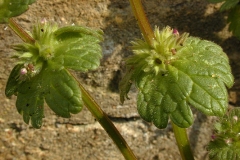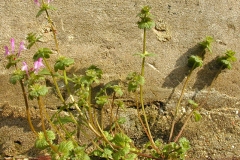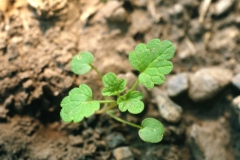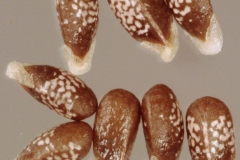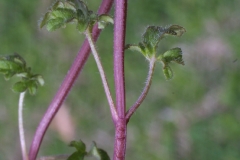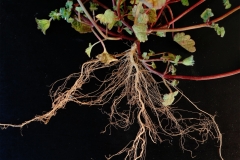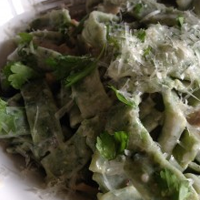| Henbit Quick Facts | |
|---|---|
| Name: | Henbit |
| Scientific Name: | Lamium amplexicaule |
| Origin | Western Europe, the Mediterranean, Asia Minor, Iran, the Himalaya, Korea, Japan, North America, North Africa, European part of the former USSR, the Caucasus, Crimea, Central Asia, Western Siberia, Eastern Siberia and the Far East |
| Colors | Initially green turning to brown as they matures |
| Shapes | Four-chambered nutlets, each containing a single seed. Nutlets are egg-shaped to oblong, 3-angled, brown with white spots, and 1-2 mm long |
| Taste | Slightly sweet and peppery taste |
| Health benefits | Good for fever, treat joint aches, stress, anxiety, chronic pain, soreness, stiffness, hypertension, scrofula, paralysis, prostate, menorrhagia, uterine hemorrhage, leucorrhea, trauma and fracture |
| Name | Henbit |
|---|---|
| Scientific Name | Lamium amplexicaule |
| Native | Western Europe, the Mediterranean, Asia Minor, Iran, the Himalaya, Korea, Japan, North America, North Africa, European part of the former USSR, the Caucasus, Crimea, Central Asia, Western Siberia, Eastern Siberia and the Far East |
| Common Names | Common henbit, giraffe head, henbit, henbit dead-nettle, Common dead-nettle, Clasping henbit, Dead nettle, Greater Henbit |
| Name in Other Languages | Afrikaans: Henbit, Turksenael, Turknael Albanian: Henbit, hithëbuta kërcellpushtuese, hithëbutë Amharic: Hīsabi (ሂሳብ) Arabic: Hilbit (هينبيت), Woudnine el Far, taqayh alghurab (taqiat alghurab), (طاقيه الغراب (طاقية الغُراب)), fam alsumkih (fum alsamakh) (فم السمكه (فُم السَمَكه)), lamiuwn multafi alsaaq (لاميون ملتف الساق) Armenian: Henbit (հենբիտ) Azerbaijani: Henbit Belarusian: Jasnotka scieblaabdymnaja (Яснотка сцеблаабдымная) Bengali: Henbit Bulgarian: Henbit, stŭbloobkhvashtashta mŭrtva kopriva (стъблообхващаща мъртва коприва) Burmese: Hainnare (ဟင်နရီ) Catalan: Flor-robí, floruví, ninoi, peu de gall, Galleret, Mataporc, Ninois, Peu de nostre senyor, Tinya negra Chinese: hen (很), bao gai cao, Bǎo gài cǎo (宝盖草) Croatian: Kopriva, obuhvatna mrtva kopriva Czech: Slepice, Hluchavka objímavá Danish: Henbit, Liden tvetand, Stängelfassende Taubnessel Dutch: Henbit, Hoenderbeet English: Henbit, Henbit Dead-nettle, Common henbit, Giraffehead, Common dead-nettle, Clasping henbit, Dead nettle, Greater Henbit Esperanto: Henbit Estonian: Henbit, hõlmlehine iminõges Filipino: Henbit Finnish: Henbit, Sepiväpeippi, Sepopeippi French: Henbit, Lamier amplexicaule, Pain de poule, lamier embrassant, lamier à feuilles embrassantes Georgian: Henbit’I (ჰენბიტი) German: Henbit, Stengelumfassende Taubnessel, Stängelumfassende Taubnessel Greek: Chinbit (χηνbit), dodekánthi (δωδεκάνθι ) Gujarati: Hēnabīṭa (હેનબીટ) Hausa: Henbit Hebrew: Nizmit lofetet, נִזְמִית לוֹפֶתֶת, נזמית לופתת Hindi: Henbit Hungarian: Arvacsalán, bársonyos árvacsalán Icelandic: Henbit, varpatvítönn Indonesian: Henbit Irish: Henbit, Caochneantóg chirce Italian: Henbit, erba ruota, lamio rotondo, falsa-ortica reniforme Japanese: Hobitto (ホビット), hotokenoza (ホトケノザ), sangaigusa (サンガイグサ), Kasumisō (カスミソウ), Ho toke no za (ほとけのざ), Sangaisō (三階草), Futsu no za (仏 の座 ) Javanese: Henbit Kabyle: Ticebbubin n wakli Kannada: Henbiṭ (ಹೆನ್ಬಿಟ್) Kazakh: Khenbit (хенбит) Korean: Amtalg (암탉), gwangdaenamul (광대나물) Kurdish: Henbit Lao: Henbit Latin: Henbit Latvian: Henbīts, skaujošā panātre Lithuanian: Henbitas, apskritalapė notrelė Macedonian: Hebit (Хебит) Malagasy: Henbit Malay: Henbit Malayalam: Henbiṟṟ (ഹെൻബിറ്റ്) Maltese: Henbit Marathi: Kōmbaḍī (कोंबडी) Mongolian: Henbit Nepali: Hēnabiṭa (हेनबिट) Netherlands: Hoenderbeet Northern Sami: Dipmačotteš Norwegian: Henbit, Kat-aug, Kattøje, Mjuktvitann, Myktvetann, Occitan: Mauvige Oriya: ହେନବିଟ୍ | Pashto: مرغۍ Persian: هیتیت, لامیوم امپلکسیکال Polish: Henbit, jasnota różowa Portuguese: Henbit, chuchapitos; menta-selvagem, chupapitos, lâmio, lâmio-violeta, urtiga-branca, Urtiga-Fohla-redonda, Punjabi: Henbit Romanian: Henbit, sugel Russian: Henbit, yasnotka stebleob”yemlyushchaya (яснотка cтеблеобъемлющая) Scottish Gaelic: Caoch-dheanntag Chearc Serbian: Henbit (хенбит), mrtva kopriva (мртва коприва), njivna kopriva (њивна коприва), njivska mrtva kopriva (њивска мртва коприва) Sindhi: Hanib (حنيب) Sinhala: Henbiṭ (හෙන්බිට්) Slovak: Hluchavka objímavá Slovenian: Henbit, njivska mrtva kopriva Spanish: Henbit, ortiga muerta de hojas abrazantes, conejitos, gallitos, lamio, morrons dobles, ortiga muerta menor, patica de gallo, zapatitos de la virgin, ortiga mansa, alagüeña, chupones, chupón, flor rubí, gargantilla, manto de la Virgen Sundanese: Henbit Swedish: Henbit, Mjukplister, Sepiväpeippi Tajik: Henbit Tamil: Heṉpiṭ (ஹென்பிட்) Telugu: Henbit Thai: Henbit Turkish: Henbit, baltutan, Büyük ballıbaba Ukrainian: Khenbit (хенбіт), hlukha kropyva stebloobhortna (глуха кропива стеблообгортна) UK: Henbit dead-nettle Upper Sorbian: Mała cycawka USA: Bee nettle, blind nettle, common dead nettle, dead nettle Urdu: مرغی Uzbek: Henbit Vietnamese: Gà mái Welsh: Henbit, Marddanadl Coch Deilgrwn, Marddanadlen Goch Gron, Marddanadlen Goch Gylchddail, Marddanhadlen Goch Cylchddail, Marddanhadlen Goch Ddeilgron, Marddanhadlen Goch Groin Zulu: I-henbit |
| Plant Growth Habit | Cool season, low-growing, winter annual, herbaceous, broadleaved weed |
| Growing Climates | Inland cliffs, rock pavements, outcrops, waste places such as roadsides, railway yards, building sites, cropland, yards, parks, fallow fields, pastures, in gardens, on lawns, on arable land, forest margins, marshes as well as a weed in agricultural fields |
| Soil | Prefers light, dry soil and cultivated soil |
| Plant Size | 10–25 cm (3.9–9.8 in) tall |
| Stem | Stem spreading then erect, tuft-like branched, glabrous below and downy above, leafless below the flowers |
| Leaf | Leaves are opposite, up to 1 inch long and nearly as wide, hemispheric to nearly round to kidney-shaped, rounded at the tip, straight across to somewhat wedge-shaped at the base, with rounded teeth along the edges and sometimes with a few shallow lobes. |
| Flowering season | April to August |
| Flower | Flowers are in whorls of 4 to 10 at the top of the plant and at leaf axils in the upper half of the stem. Individual flowers are ½ to ¾ inch long, pinkish-purple, irregular with 2 lips at the end of a long, slender tube. The lower lip is divided into two rounded lobes. Each lobe has a dark purple spot in its center. The upper lip is shaped like a hood. |
| Fruit Shape & Size | Four-chambered nutlets, each containing a single seed. Nutlets are egg-shaped to oblong, 3-angled, brown with white spots, and 1-2 mm long |
| Fruit Color | Initially green turning to brown as they matures |
| Seed | Seeds are light to dark brown. |
| Taste | Slightly sweet and peppery taste |
| Plant Parts Used | Stems, leaves, and flowers |
| Propagation | By seed |
| Other Facts |
|
| Precautions |
|
Plant Description
Henbit is a cool season, low-growing, winter annual, herbaceous, broadleaved weed that normally grows about 10–25 cm (3.9–9.8 in) tall with soft, finely hairy stems. The plant is found growing in inland cliffs, rock pavements, outcrops, waste places such as roadsides, railway yards, building sites, cropland, yards, parks, fallow fields, pastures, in gardens, on lawns, on arable land, forest margins, marshes as well as a weed in agricultural fields. It prefers light, dry soil and cultivated soil. Seedling stems are square, green to purple, with basally pointing hairs. Mature stems are square, green to purple, nearly hairless, prostrate or curved at the base, with an erect or ascending tip, and typically many-branched near the base.
Leaves
Leaves are opposite, up to 1 inch long and nearly as wide, hemispheric to nearly round to kidney-shaped, rounded at the tip, straight across to somewhat wedge-shaped at the base, with rounded teeth along the edges and sometimes with a few shallow lobes. Surfaces are sparsely hairy; lower leaves are petiolated, rounded to heart-shaped, with rounded teeth. Upper leaves are sessile, deeply lobed, encircling the stem at the base.
Flower
Flowers are in whorls of 4 to 10 at the top of the plant and at leaf axils in the upper half of the stem. Individual flowers are ½ to ¾ inch long, pinkish-purple, irregular with 2 lips at the end of a long, slender tube. The lower lip is divided into two rounded lobes. Each lobe has a dark purple spot in its center. The upper lip is shaped like a hood. The outside of the corolla is pinkish purple. The inner portion is white with purple spots or lines. Inside the tube are 4 stamens. The calyx surrounding the base of the tube is 5-lobed, densely hairy, and up to about 1/3 inch long. Henbit also produces inconspicuous cleistogamous flowers. These flowers never open and fertilize themselves. This plant flowers very early in the spring even in northern areas, and for most of the winter and the early spring in warmer locations such as the Mediterranean region. At times of year when there are not many pollinating insects, the flowers self-pollinate.
Fruits
Fertile flowers are followed by four-chambered nutlets, each containing a single seed. Nutlets are egg-shaped to oblong, 3-angled, brown with white spots, and 1-2 mm long. Four nutlets, each with 1 seed, are enclosed within the persistent sepals. Seeds are light to dark brown.
Traditional uses and benefits of Henbit
- It is used medicinally for traumatic injury.
- According to Natural Medicinal Herbs this edible plant is anti-rheumatic, diaphoretic, an excitant, febrifuge, a laxative and a stimulant.
- Henbit has been used in herbal remedies to reduce fever, induce sweating, and treat joint aches.
- Some people create henbit green smoothies to aid digestion and boost energy.
- Henbit herbal tea has stimulant and excitant effects which means it could help relieve stress and anxiety.
- Plants have been said to be a source of fiber to regulate the digestive tract and iron to develop the protein hemoglobin for oxygen transport through the bloodstream.
- Poultice of henbit can treat external bleeding, burns, bruises, stings, and wounds.
- Tea can be used to treat diarrhea.
- It relieves chronic pain and discomfort in joints and connective tissue.
- It is anti-rheumatic and anti-inflammatory, so it’s great for relieving chronic pain, soreness, and stiffness.
- It can help with menstrual cramps and excessive bleeding.
- It is also used for the treatment of hypertension, scrofula, paralysis, prostate, menorrhagia, uterine hemorrhage, leucorrhea, trauma, fracture
Culinary Uses
- It is added to salads or used as a potherb.
- Young leaves can be eaten raw, added to salads or used as an herb seasoning, or cooked as leafy greens.
- You can add it raw to salads, soups, wraps, or green smoothies.
- The leaves can also be dried and used as a tea.
- Henbit can be finely chopped and tossed into salads, used as a topping over pizza, or pureed into a pesto.
- Leaves can also be blended into smoothies, layered into sandwiches, or minced and stirred into herbal dips.
- Henbit can be included into soups, curries, and stews, cooked into stir-fries, mixed into frittatas and omelets, or stirred into fritter batter.
Henbit Noodles with Creamy Mushroom Sauce
Ingredients
- 1/2 pound henbit leaves
- 2 eggs
- 1 T extra-virgin olive oil
- 1 garlic clove, peeled
- 3/4 cup freshly grated parmesan or peccorino romano cheese, divided
- 1 1/2 cups all-purpose flour, divided
- 3/4 cup semolina flour
- 2 tablespoons butter
- 1 cup chopped fresh mushrooms or reconstituted from dried (save soaking liquid)
- 1 cup mushroom stock (or soaking liquid from dried mushrooms) OR vegetable or chicken stock
- 2 tablespoons dry white wine
- 1/2 cup light cream
- 1/4 teaspoon dried or 3/4 teaspoon fresh thyme leaves
- freshly ground black pepper
- salt to taste
Directions
For the Noodles
- Simmer the henbit leaves in very little water for 5 minutes. Drain in a colander and immediately run cold water over them. Squeeze out as much liquid as possible.
- Pulse the cooked henbit and the peeled garlic in a food processor (or finely mince with a knife).
- Add the egg and puree the ingredients (or mash together with a fork if not using a food processor).
- Reserve 1/3 cup of the all-purpose flour. Whisk together the rest of the all-purpose and the semolina flours in a large bowl. Dump the contents of the bowl out onto a clean counter or cutting board. Make a well (indentation) in the center.
- Pour the egg-henbit mixture into the well in the center of the flour. Mix the flour into the liquid mixture with a fork.
- Knead the mixture by hand for 10 minutes (or in a stand mixer with the bread hook or food processor with the dough blade until the dough comes together into a ball). Kneading by hand is better because you have more control of how much flour ends up in the dough: stop incorporating more as soon as it is possible to knead the dough without it sticking to your fingers.
- Cover the dough with a clean, damp kitchen towel and let it rest for 30 minutes.
- Lightly dust your work surface with flour. Cut the rested dough into quarters. Roll one of the quarters out with a rolling pin or an old wine bottle until it is as thin as you can get it. Turn the dough over frequently while you roll it out, and dust it with additional flour as necessary to prevent it from sticking to your rolling implement.
- Give the rolled out dough one more light sprinkling of flour then roll it up into a loose cigar shape. Cut crosswise so that it forms coils of 1/4 to 1/2 – inch wide noodles. Uncoil the coils and lightly dust them with additional flour.
For the Sauce
- If you’re using dried mushrooms, first soak them in boiling hot water for 15 minutes. Drain (reserving the soaking liquid) and squeeze out as much liquid as possible. Whether you started with fresh mushrooms or dried, coarsely chop them.
- Melt the butter in a skillet over medium low heat. Add the mushrooms and a little salt. Cook, stirring often, until the mushrooms give up their liquid and then most of the liquid evaporates.
- Add 2 tablespoons all-purpose flour and cook, stirring, for 2 minutes. Raise the heat to medium high.
- Add the thyme and the white wine and cook, stirring, for another 2 minutes.
- Add the mushroom soaking liquid (if you started with dried mushrooms) and/or the stock a small splash at a time, stirring constantly. Each addition should thicken before you add more liquid. When it is all the consistency of thick gravy, turn off the heat and add the cream and salt and pepper to taste.
Bring It Together
- Bring a large pot of salted water to a boil. Add the fresh henbit noodles and stir gently. Cook for 2 – 3 minutes. Drain. Return to the pot; add the sauce and 1/4 cup of the grated cheese. Toss gently to coat the noodles with the sauce. Add salt and pepper to taste.
- Serve with additional grated cheese and a little minced fresh henbit sprinkled over as a garnish (or parsley).
Henbit Flapjacks
Ingredients
- 2 cups flour
- 4 T sugar
- 1 1/2 t salt
- 1 T baking powder
- 2 cups milk
- 3 T oil
- 2 eggs
- 1 cup diced Henbit (leaves, flowers and stems if not too woody)
- Butter for frying
Directions
- Mix dry ingredients together.
- Add liquid ingredients and mix.
- Fold in Henbit.
- Fry in butter.
- Serve with your choice of topping such as honey, syrup or preserves.
Cannelloni Bean and Henbit Soup
Ingredients
- 2 T olive oil
- 4 cloves garlic, peeled and chopped
- 1 onion, chopped
- 6 cups chicken or vegetable broth
- 1 can (15.5 oz.) Cannelloni beans, drained and rinsed
- 1 cup small pasta
- 1 1/2 cups chopped Henbit
- Salt and pepper to taste
- Parmesan cheese (optional)
Directions
- Heat olive oil in stock pot. Add garlic and onion and fry until translucent, about 10 minutes.
- Add broth and bring to a boil. Add beans and pasta. Boil until pasta is tender, about 8 to 10 minutes. Add Henbit and cook several minutes until wilted. Season with salt and pepper to taste.
- Top with Parmesan cheese when serving. Makes about six servings.
Prevention and Control
Due to the variable regulations around (de)registration of pesticides, your national list of registered pesticides or relevant authority should be consulted to determine which products are legally allowed for use in your country when considering chemical control. Pesticides should always be used in a lawful manner, consistent with the product’s label.
Cultural Control
Intensive agriculture, especially spring and summer tillage that does not allow L. amplexicaule plants to mature will manage populations over time.
Mechanical Control
Although not practical in winter cereals, tillage/cultivation in summer row-crops is effective for control of L. amplexicaule seedlings. The same is true for hoeing in home gardens and similar areas that can be managed by hand.
Biological Control
Although L. amplexicaule is a host to a large number of crop pests, none is known to be specific to this weed or has been researched as a potential biological control agent.
Chemical Control
Numerous herbicides are highly effective in controlling L. amplexicaule; however, selection of an herbicide that is selective to the crop in question must be done carefully.
Integrated Control
In agronomic and horticultural crops, L. amplexicaule can be managed through a combination of cultural, mechanical and chemical measures.
References:
https://www.itis.gov/servlet/SingleRpt/SingleRpt?search_topic=TSN&search_value=32539#null
http://www.hear.org/pier/species/lamium_amplexicaule.htm
https://pfaf.org/User/Plant.aspx?LatinName=Lamium+amplexicaule
https://www.cabi.org/isc/datasheet/29728#tosummaryOfInvasiveness
https://extension.tennessee.edu/publications/Documents/W165.pdf
https://www.ediblewildfood.com/henbit.aspx


